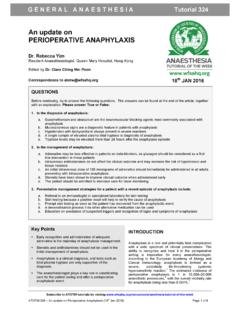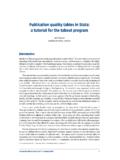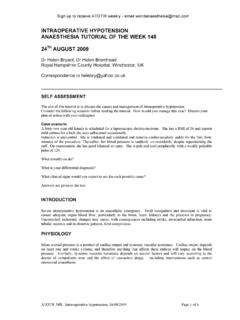Transcription of Latex Allergy Dr Valasubramaniam Mahadevan, …
1 Latex Allergy Dr Valasubramaniam mahadevan , great Ormond Street Hospital, London A 32-year-old nurse, with a history of atopy, was taken to theatre for a dental procedure under general anaesthesia. She had previously undergone uneventful general anaesthesia. Following intravenous induction with fentanyl, propofol and atracurium she was intubated with an oral endotracheal tube and anaesthesia was maintained with isoflurane in nitrous oide and oygen. After twenty minutes, she became hypotensive at 70/50 mmHg with a pulse rate of 130 beats/minute and developed a widespread urticarial rash. 1. These features are suggestive of an anaphylactic reaction. What are the most likely causes? 2. What might suggest a diagnosis of Latex Allergy ?
2 3. How does Latex Allergy present? 4. Are any people predisposed to develop Latex Allergy ? 5. What are the routes of exposure to Latex ? 6. How can the diagnosis be confirmed? 7. How should this patient be managed? 8. How will you plan the perioperative care for a patient with known Latex Allergy ? 9. How can we prevent sensitization to Latex in health care workers? Anaphylaxis under anaesthesia can be due to various causes and it is often difficult to ascertain the particular cause. Reactions to drugs administered during anaesthesia such as thiopentone, muscle relaxants, colloidal fluids and antibiotics usually present almost immediately after IV administration of the drug, while reactions due to Latex normally take 30-40 minutes to develop.
3 Latex is the second most frequent cause for anaphylaxis under anaesthesia and is responsible for between 12 and 17% of reactions. The medical history, the timing of the event and the clinical presentation may all suggest the diagnosis of Latex Allergy . It should always be considered as a potential cause in perioperative anaphylaxis as failure to do so may lead to the wrong diagnosis and another life threatening event on a repeat eposure. Predisposition to late Allergy Specific groups of patients may become sensitized to Latex and be at risk of anaphylaxis: Patients with a history of multiple surgical procedures, especially those with spina bifida and genitourinary anomalies Occupational exposure to Latex including health care personnel Individuals with a history of atopy such as hay fever, rhinitis, asthma or eczema Individuals with history of Allergy to tropical foods such as avacoda, kiwi fruit and banana Latex antigens may enter the body in a variety of ways.
4 Among health care workers the commonest Latex contact is via the skin or mucous membrane by medical glove. A. variety of Latex proteins are contained in gloves, one of the most important being Havea Brasilensis b (Hev b). In addition Cornstarch powder, used as a donning agent for gloves, binds to the Latex proteins and acts as a carrier which is released in air and may cause respiratory symptoms when inhaled. These allergen carrying powders can remain suspended in the air for as long as 5 hours and can be easily transferred through items such clothing, phones and other inanimate objects. The risk of sensitization increases among individuals who have atopy or dermatitis. Other sources of Latex include urinary catheters, tourniquets, rubber plungers of syringes, IV tubing and tapes.
5 In addition to spread from skin contact and inhalation, other routes include wound inoculation, ingestion and parental injections. In UK, many previously Latex containing equipment has been replaced by non- Latex containing variants to decrease the risk of sensitisation and reactions. Allergic reactions with Latex There are a variety of reactions associated with Latex . Latex sensitization is defined as the presence of immunoglobulin IgE antibodies but without clinical manifestations and does not lead to Allergy . Latex Allergy is an immunologically mediated reaction to Latex with clinical symptoms that are either type IV or type I mediated hypersensitivity. In type IV reactions, a delayed onset immunological reaction results from T-cell mediated sensitization to additives of Latex .
6 The reaction begins 48-72 hrs after repeat exposure and manifestations include erythema, vesicles and rash an allergic contact dermatitis. The more commonly seen irritant contact dermatitis associated with usage of powdered gloves or chemicals is most likely secondary to the alkaline pH rather than the allergic protein. The extent of involvement depends on duration of exposure and skin temperature. Type I is the most severe reaction resulting from sensitization and production of IgE. antibodies. Upon re-exposure, Latex proteins cross-link IgE antibodies on the surface of the mast cells and basophils and lead to degranulation. If the exposure is airborne, reaction develops slowly and can lead to utricaria, rhinitis and conjunctivitis.
7 More severe reactions occur shortly after parenteral or mucous membrane exposure and symptoms include flushing, vasodilatation, bronchospasm, increased vascular permeability and cardiovascular collapse. Blood taken during the acute phase of anaphylaxis and 6 hours later may reveal elevated serum tryptase levels, which indicates mast cell activation. Retrospective diagnosis is either by skin testing (performed 4-6 weeks after the acute episode) or measuring serum IgE antibody levels using radio-allergosorbent testing. It is highly specific but poorly sensitive and the results are divided into seven classes from class 0-class VI with class VI being the most severe form. Management of Latex anaphylaxis Management of anaphylaxis due to Latex Allergy includes discontinuation of the exposure and should follow the usual guidelines for managing anaphylaxis in general.
8 It includes management of the airway, breathing, circulation and administration of resuscitation drugs. Adrenaline (epinephrine) is the single most important drug and may be administered IM, or more commonly in theatre IV. Repeat injections or infusions may be necessary. Other drugs include antihistamines, bronchodilators and corticosteroids. Anaesthesia for patients allergic to Latex Strategy for perioperative management of patients with a history of Latex Allergy : Identification of at risk groups. Patients with previous allergic reactions to Latex in a healthcare setting, or describing a facial rash when blowing up balloons, or condom intolerance. Allergies to avocado or kiwi fruit may cross react with Latex .
9 Providing Latex free environment: All the anaesthetic and surgical equipment containing Latex should be replaced with Latex free alternates. Most equipment is marked to determine whether Latex containing of Latex free. The patient identity band should state Latex Allergy . Close coordination between all the health care personnel involved in the patient care to ensure whenever possible patient should be scheduled as the first case of the day when the airborne Latex particles will be at a minimum. The theatre should be identified as treating a patient with Latex Allergy to avoid other staff entering with Latex gloves or without scrubbing after taking off Latex gloves. Drugs contained in vials with rubber bungs should not be pierced with needles and rather the drug is loaded after removing the bung.
10 Ensure all IV equipment is Latex free. Pre-treatment with steroids is not recommended. Every hospital should have a protocol in place for managing such patients and Latex free trolley should be readily available. The protocol followed at great Ormond Street Hospital, London is available online see further reading. There is currently no cure for Latex Allergy and avoidance of Latex containing products is the only way to reduce the risk. The prevalence among health care workers ranges from 3. -12%. In a study published in Anesthesiology the prevalence of Latex sensitization among Anaesthetists was reported to be as high as %. It is considered appropriate that anaesthetists, as well as other health care professionals, use Latex free gloves or non- powdered gloves with low Latex protein count to prevent sensitization.


















